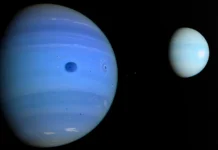The planet Jupiter, the largest gas giant in our solar system, continues to amaze the scientific community with its complexity. Recently, a remarkable discovery has come to add a new layer of mystery to its atmospheric behavior and intense magnetism. Researchers have identified a tiny atmospheric jet buried deep in the planet's atmosphere that appears to fluctuate in an unexpected way every four years, behaving like a wave.
This unusual sighting raises new questions about Jupiter's internal dynamics, particularly about the workings of the "Great Blue Spot" – an area of intense magnetism located near the planet's equator. Contrary to what the name might suggest, this region is not visually blue. The name comes from the way scientists visualize maps of Jupiter's magnetic field, using a symbolic color palette to mark different magnetic intensities.
Jupiter's magnetic field exhibits a remarkable asymmetry relative to its axis of rotation, so pronounced that the Great Blue Spot is often compared to a second magnetic south pole emerging from the planet's equator. This unique feature is accentuated by the fact that some parts of the region are influenced by a jet moving westward, while other segments are pulled by strong easterly winds.
Planet Jupiter: The INCREDIBLE Discovery that Deepens the Mysteries of the Planet in the Solar System
Recent findings, presented in a paper published in the journal Nature, shed new light on this phenomenon. Using data sent by NASA's Juno probe, currently orbiting Jupiter, researchers mapped the Great Blue Spot and investigated its changes. Like ocean waves changing their speed, this new data suggests that wave-like behavior deep in Jupiter's metallic core could be the source of these observed fluctuations in the magnetic field.
Professor Yohai Kaspi, of the Weizmann Institute of Science in Israel and co-investigator of the Juno mission, emphasized the mystery surrounding this phenomenon, noting that it is still not understood why the region exhibits these magnetic anomalies. Observations indicate that strong winds from Jupiter's turbulent "surface" play a crucial role in driving these intense magnetic fields, blowing down to depths of more than 3.000 kilometers, where they are thought to influence the planet's intense magnetic field.
However, despite this important finding, researchers are cautious about drawing definitive conclusions. The discovered jet moves on a relatively small scale, at speeds of a few centimeters per second, significantly different from other known atmospheric jets on Jupiter, which move much faster. This detail emphasizes the "marginal" character of measurements current, requiring more data to confirm fluctuations every four years.
More observations provided by the Juno mission in the future could provide the answers needed to unravel this cosmic puzzle, helping scientists better understand the dynamics that power Jupiter's complex magnetic field. These findings not only add to our knowledge of the gas giant, but also open new perspectives for understanding solar-scale magnetic processes.

















